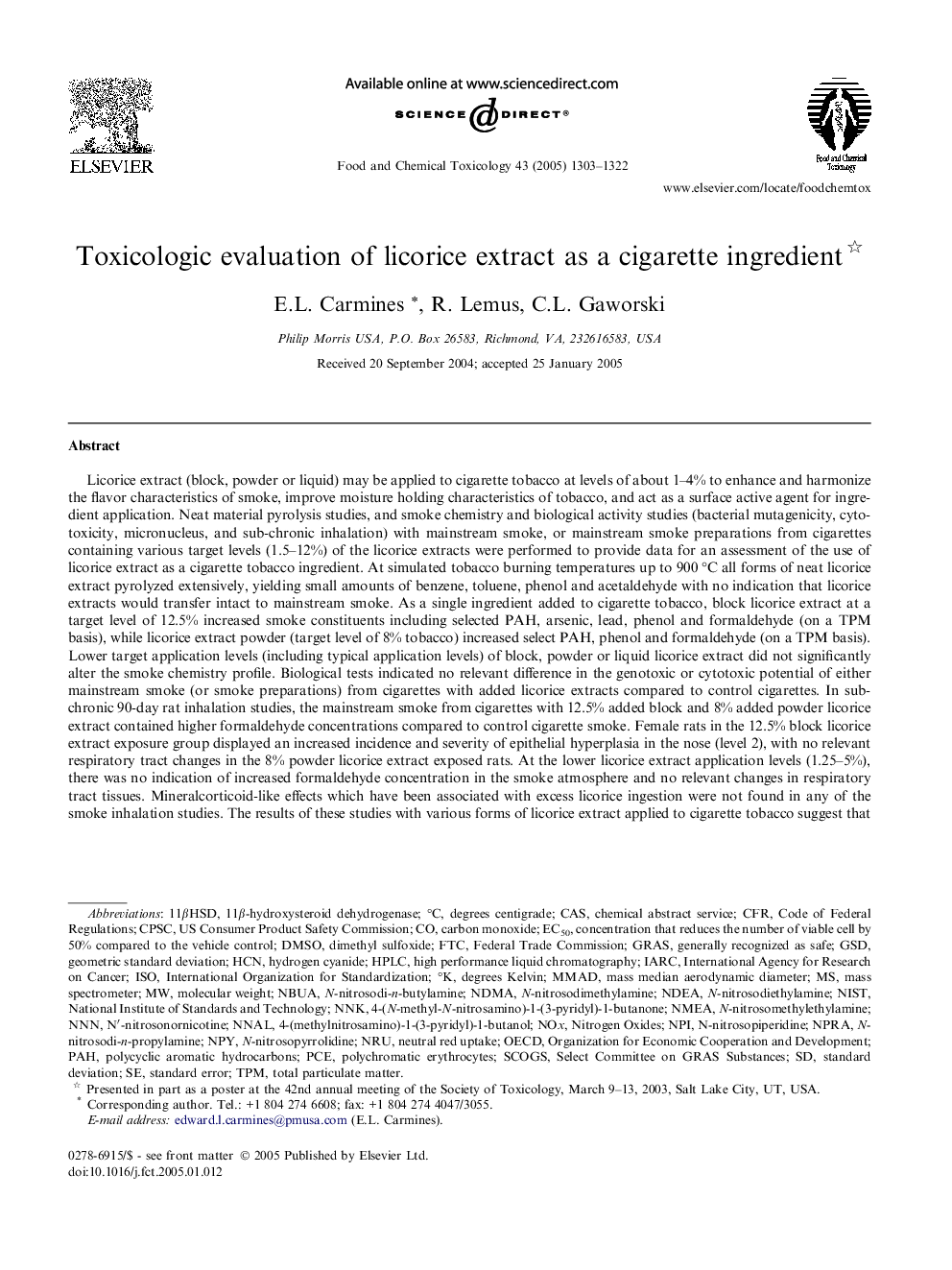| کد مقاله | کد نشریه | سال انتشار | مقاله انگلیسی | نسخه تمام متن |
|---|---|---|---|---|
| 9031143 | 1130970 | 2005 | 20 صفحه PDF | دانلود رایگان |
عنوان انگلیسی مقاله ISI
Toxicologic evaluation of licorice extract as a cigarette ingredient
دانلود مقاله + سفارش ترجمه
دانلود مقاله ISI انگلیسی
رایگان برای ایرانیان
کلمات کلیدی
NDEA, N-nitrosodiethylaminePCE, polychromatic erythrocytesMMAD, mass median aerodynamic diameterNNAL, 4-(methylnitrosamino)-1-(3-pyridyl)-1-butanolHCN, hydrogen cyanideMS, mass spectrometerCAS, chemical abstract serviceNRU, neutral red uptakeNIST, National Institute of Standards and TechnologyFTC, Federal Trade CommissionCFR, Code of federal regulations - CFR، کد قوانین فدرالCO, carbon monoxide - CO، مونوکسید کربنGRAS, Generally Recognized as Safe - GRAS، به طور کلی به عنوان امن شناخته شده استGSD, Geometric Standard Deviation - GSD، انحراف استاندارد هندسیIARC, International Agency for Research on Cancer - IARC، آژانس بین المللی تحقیقات سرطانNDMA, N-nitrosodimethylamine - NDMA، N-nitrosodimethylamineNOx, Nitrogen oxides - NOx، اکسید نیتروژنOECD, Organization for Economic Cooperation and Development - OECD، سازمان همکاری های اقتصادی و توسعهPAH, polycyclic aromatic hydrocarbons - PAH، هیدروکربن های آروماتیک چند حلقه ایSE, standard error - SE، خطای استانداردSD, standard deviation - انحراف معیارISO, International Organization for Standardization - ایزو، سازمان بین المللی استاندارد سازیDMSO, dimethyl sulfoxide - دیمتیل سولفواکسیدMW, molecular weight - وزن مولکولیHPLC, high performance liquid chromatography - کروماتوگرافی مایع با کارایی بالا،HPLC
موضوعات مرتبط
علوم زیستی و بیوفناوری
علوم کشاورزی و بیولوژیک
دانش تغذیه
پیش نمایش صفحه اول مقاله

چکیده انگلیسی
Licorice extract (block, powder or liquid) may be applied to cigarette tobacco at levels of about 1-4% to enhance and harmonize the flavor characteristics of smoke, improve moisture holding characteristics of tobacco, and act as a surface active agent for ingredient application. Neat material pyrolysis studies, and smoke chemistry and biological activity studies (bacterial mutagenicity, cytotoxicity, micronucleus, and sub-chronic inhalation) with mainstream smoke, or mainstream smoke preparations from cigarettes containing various target levels (1.5-12%) of the licorice extracts were performed to provide data for an assessment of the use of licorice extract as a cigarette tobacco ingredient. At simulated tobacco burning temperatures up to 900 °C all forms of neat licorice extract pyrolyzed extensively, yielding small amounts of benzene, toluene, phenol and acetaldehyde with no indication that licorice extracts would transfer intact to mainstream smoke. As a single ingredient added to cigarette tobacco, block licorice extract at a target level of 12.5% increased smoke constituents including selected PAH, arsenic, lead, phenol and formaldehyde (on a TPM basis), while licorice extract powder (target level of 8% tobacco) increased select PAH, phenol and formaldehyde (on a TPM basis). Lower target application levels (including typical application levels) of block, powder or liquid licorice extract did not significantly alter the smoke chemistry profile. Biological tests indicated no relevant difference in the genotoxic or cytotoxic potential of either mainstream smoke (or smoke preparations) from cigarettes with added licorice extracts compared to control cigarettes. In sub-chronic 90-day rat inhalation studies, the mainstream smoke from cigarettes with 12.5% added block and 8% added powder licorice extract contained higher formaldehyde concentrations compared to control cigarette smoke. Female rats in the 12.5% block licorice extract exposure group displayed an increased incidence and severity of epithelial hyperplasia in the nose (level 2), with no relevant respiratory tract changes in the 8% powder licorice extract exposed rats. At the lower licorice extract application levels (1.25-5%), there was no indication of increased formaldehyde concentration in the smoke atmosphere and no relevant changes in respiratory tract tissues. Mineralcorticoid-like effects which have been associated with excess licorice ingestion were not found in any of the smoke inhalation studies. The results of these studies with various forms of licorice extract applied to cigarette tobacco suggest that adding licorice extract to cigarette tobacco at levels of ⩽5% does not discernibly alter the smoke chemistry or biological effects normally associated with mainstream cigarette smoke.
ناشر
Database: Elsevier - ScienceDirect (ساینس دایرکت)
Journal: Food and Chemical Toxicology - Volume 43, Issue 9, September 2005, Pages 1303-1322
Journal: Food and Chemical Toxicology - Volume 43, Issue 9, September 2005, Pages 1303-1322
نویسندگان
E.L. Carmines, R. Lemus, C.L. Gaworski,